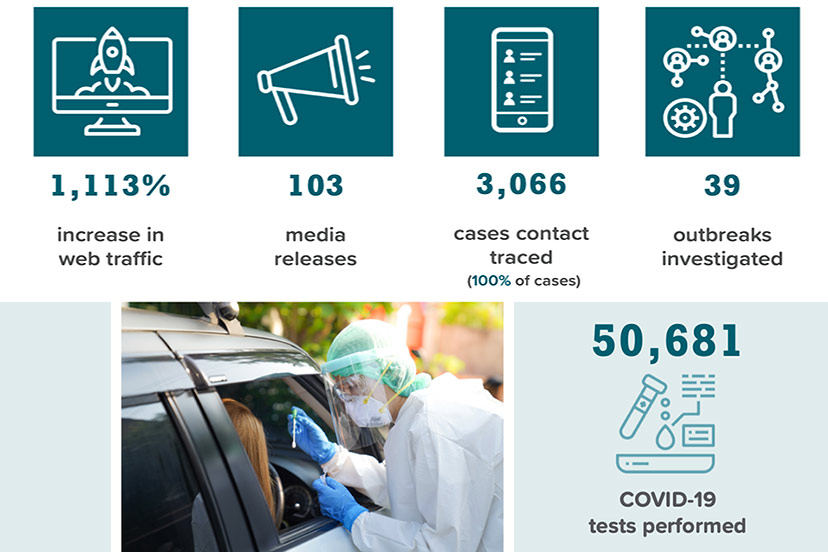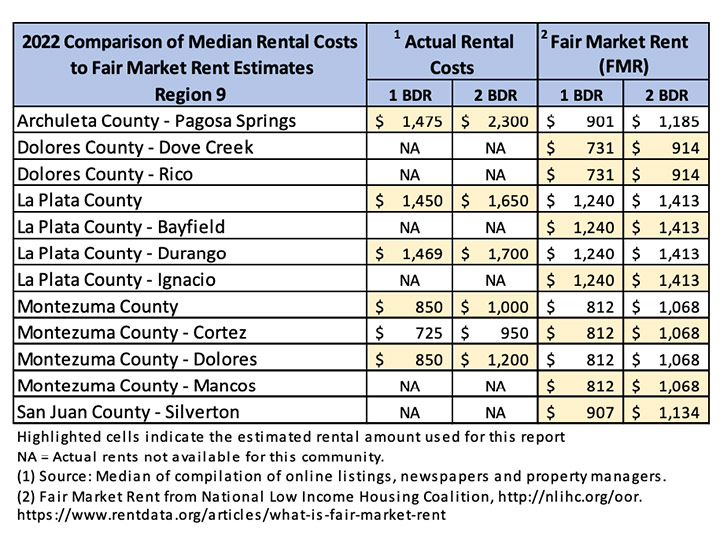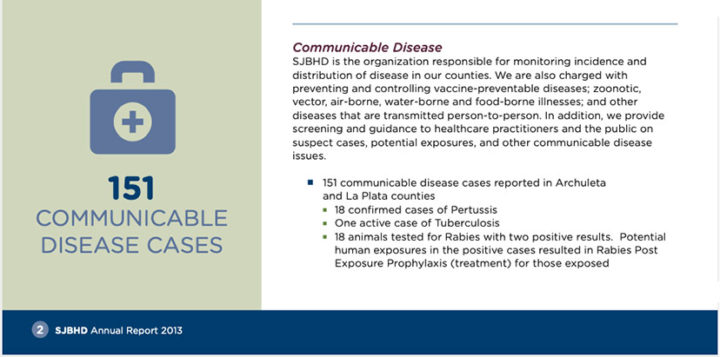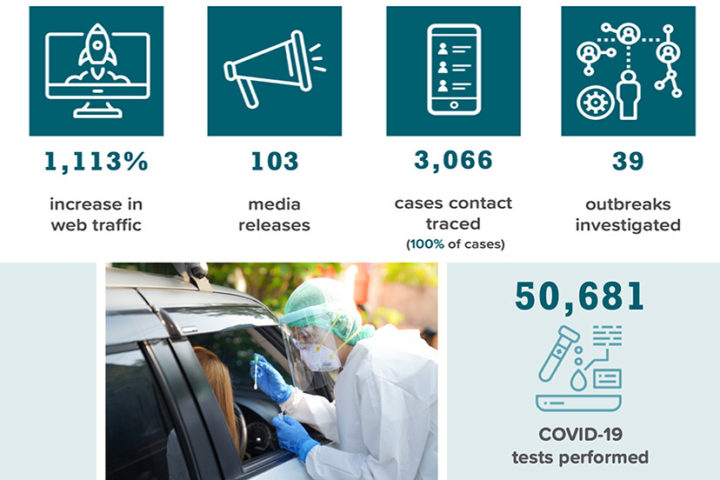Region 9 Economic Development District, based in Durango, issued its 2022 “Livable Wage in Southwest Colorado” update recently.
The update, written by analyst Donna Graves, covers five counties in the southwest corner of Colorado, and specifically mentions Pagosa Springs in its Executive Summary:
In Region 9, the amount needed to be economically self-sufficient varies by geographic location. The 2022 Colorado minimum wage is $12.56 per hour, which amounts to $26,527 per year working full time. We found that in Region 9, Montezuma County is the least expensive ($71,292 annually), and Archuleta County is the most expensive place to live ($92,796 annually) for a family of four. Using housing and childcare costs specific to each community we found that the Town of Pagosa Springs is also the most expensive community in the region for a family of four ($21.97 per hour for each working adult) due to the high cost of housing.
More specifically, the report notes that the National Low Income Housing Coalition estimates the “Fair Market Rent” for Archuleta County at about $1,185 for a 2-bedroom rental. Current rent in Pagosa, for a 2-bedroom, is twice that amount: $2,300.
Not exactly an attractive place for a family of four, it seems.
You can download the full report here.
The reasons for Archuleta County’s oppressive economy — oppressive, that is, for working families — are not immediately clear. Unfettered vacation rental development? Too many tourists? Too many second-homes? Greedy landlords? A general failure, by our local leaders, to understand how the economy works?
For perhaps very different reasons, it would appear that ‘public health’ is also destined to become more expensive in Archuleta County in the near future.
According to a story by reporter Josh Pike published in the weekly Pagosa Springs SUN, Marsha Porter-Norton — the La Plata Board of County Commissioners’ representative to the San Juan Basin Public Health (SJBPH) district Board of Health — told her fellow Board of Health members, on June 30, that the La Plata commissioners have directed County staff to study the financial situation at SJBPH and deliver a report to the BOCC.
From the SUN article:
Porter-Norton indicated that she expected to have a work product from her staff in 45 to 60 days. She added that the board would be “very transparent” about when the issue would come to the BOCC for a decision.
As noted previously in this editorial series, La Plata and Archuleta County formed a joint public health district some 70 years ago, and have been sharing the job of helping fund the district, based on each county’s population… with La Plata County contributing about four times as much tax money as Archuleta County.
The lion’s share of SJBPH’s $8.6 million budget, however, has been funded by state and federal grants. For 2022, the Archuleta County government contributed only about $280,000 to the SJBPH budget. Fees for services, charged to Archuleta County residents, were estimated at about $275,000.
If we do the math, it appears that Archuleta County has been receiving about $1.7 million worth of public health services, for a total community investment of maybe $550,000.
Despite the relatively low cost of the health district, as a portion of the Archuleta County budget, the Archuleta Board of County Commissioners began, last year, seriously questioning our community’s continued participation in the joint district. Much of the criticism focused on SJBPH’s approach to the COVID crisis.
Criticism of SJBPH policies and staff did not sit well with the district, nor with the Board of Health. Or so it would seem.
It now appears that at least one La Plata County commissioner would like to dissolve the joint district, and have each county establish its own public health agency.
Over the weekend, I downloaded a couple of annual reports from the SJBPH website. (You can find those reports here.)
Back in 2013, SJBPH had a relatively simple job, when it came to tracking communicable diseases. 151 cases?
According to the 2013 annual report, only 37 communicable disease cases were worthy of specific mention. 18 cases of pertussis, 18 possible cases of rabies (but only two positive results), and one case of tuberculosis.
Not too bad, for a joint population of about 64,000 people in the two counties. SJBPH seemed to have a pretty good handle on the communicable disease end of things.
Then… along comes the COVID crisis. Suddenly, SJBPH was managing 50,681 COVID-19 tests per year. (The image below is from the 2021 annual report.)
If we’re going to look at this situation sympathetically, SJBPH did not have enough staff to handle 50,000 tests, when COVID arrived, nor did the staff have experience with a ‘global pandemic’. The tests themselves were ‘untested’. SJBPH had no access to vaccines, because none existed. In terms of preventing the spread of a highly communicable disease, SJBPH had little choice other than to accept the recommendations (the ‘ever-changing’ recommendations?) coming from the Centers for Disease Control (CDC) and the National Institutes of Health (NIH).
SJBPH also needed to follow the mandates established by the Polis administration in Denver, despite the initially low case count in Archuleta County.
No one really knew how to handle this crisis. We — the public — were guessing at the seriousness of the situation, based on conflicting scientific information, and in the midst of a concerted national effort to censor anyone who questioned the “accepted scientific viewpoint”.
As far as I can tell, the SJBPH staff never questioned that “accepted scientific viewpoint”… and that unquestioning acceptance didn’t sit well with the Archuleta BOCC, nor did it sit well with a sizable number of Pagosa citizens.
As of July 2022, 33% of the Archuleta County population have avoided the COVID vaccines completely. (You can view the data here.) Only 61% have been “fully immunized”. (I’m not sure what “fully immunized means”.) It appears that the vaccines did not successfully contain the disease, even among those who were immunized.
The rate of new cases in Archuleta County, at the moment, is similar to the rate last summer. The SJBPH data dashboard does not report the rate of hospitalizations, however, so we have no clear idea about the ‘seriousness’ of the current situation, in terms of life-threatening cases.
According to the reports we’ve heard, it would take at least one year for La Plata County to separate itself from the joint public health district. That separation — if implemented — would require Archuleta County to create its own, independent public health agency.
What’s less clear is how Archuleta County could manage to provide the (approximately) $1.7 million worth of services we’re currently getting from San Juan Basin Public Health.
Or if we even want those services?




